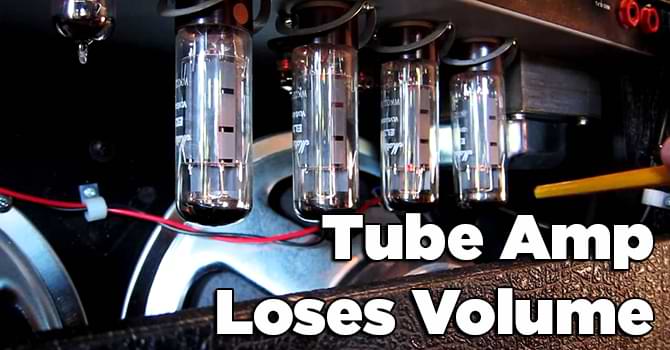Tube Amp Loses Volume [Reason & Fix]
A tube amplifier losing volume or experiencing low output can be a common issue, and it can be caused by various factors. This guide will help you diagnose the reasons behind this problem and provide effective solutions to fix it.

# Table of Contents =>
- 1 Reasons for Tube Amp Loses Volume or Having Low Output:
- 1.1 a) Worn-out Tubes:
- 1.2 b) Mismatched or Incorrect Tubes:
- 1.3 c) Tube Biasing Issues:
- 1.4 d) Dirty or Oxidized Tube Sockets:
- 1.5 e) Faulty Components:
- 1.6 f) Loose or Damaged Wiring:
- 1.7 g) Speaker Issues:
- 1.8 Effective Ways to Fix Tube Amp Volume Issues:
- 1.9 a) Replace Worn-out Tubes:
- 1.10 b) Check & Adjust Bias:
- 1.11 c) Clean Tube Sockets:
- 1.12 d) Inspect & Replace Components:
- 1.13 e) Check Wiring & Connections:
- 1.14 f) Test with Different Speaker/Cable:
- 1.15 g) Regular Maintenance:
- 1.16 Conclusion:
- 1.17 FAQs –
Reasons for Tube Amp Loses Volume or Having Low Output:
a) Worn-out Tubes:
Tubes possess a limited operational lifespan, and as they age, they can deteriorate, resulting in diminished output & a decrease in volume. If your amplifier has been in continuous use for an extended period, it’s conceivable that one or more tubes may require replacement. Conduct a visual inspection of the tubes to identify any indications of damage or irregular illumination, and contemplate replacing them as needed.
b) Mismatched or Incorrect Tubes:
Using tubes that are not properly matched to your amplifier’s specifications can result in low output or loss of volume. Ensure that you are using the correct type and matched pairs of tubes as recommended by the manufacturer.
c) Tube Biasing Issues:
Tube amplifiers require proper biasing to operate at their full potential. Incorrect bias settings can lead to uneven output and volume drops. Consult your amp’s manual for instructions on how to bias the tubes correctly, or have a professional technician do it for you.
d) Dirty or Oxidized Tube Sockets:

Over time, the tube sockets can accumulate dirt and oxidation, which can lead to poor connections and volume issues. Carefully clean the tube sockets with a contact cleaner and ensure a tight connection when re-seating the tubes.
e) Faulty Components:
Internal components such as capacitors, resistors, or transformers can fail or degrade over time, resulting in volume loss. A qualified technician can diagnose and replace these components if necessary.
f) Loose or Damaged Wiring:
Inspect all the internal and external wiring for loose connections or damage. Loose wires can cause intermittent volume issues. Re-solder or replace any damaged wires.
g) Speaker Issues:
A faulty speaker or speaker cable can also cause volume problems. Test your amp with a different speaker cabinet and cable to rule out any issues with your current setup.
Effective Ways to Fix Tube Amp Volume Issues:
a) Replace Worn-out Tubes:

If your tubes are old and worn, replacing them with new, matched tubes can often restore the volume and overall performance of your amp. Consult your amp’s manual or manufacturer’s recommendations for the appropriate tube replacements.
b) Check & Adjust Bias:
Ensure that your amp’s tubes are correctly biased. If you’re unsure how to do this, seek assistance from a professional technician. Incorrect biasing can damage your amp and tubes.
c) Clean Tube Sockets:
Use a contact cleaner or deoxit to clean the tube sockets. Gently reseat the tubes to ensure a good connection.
d) Inspect & Replace Components:
If you suspect faulty internal components, consult a qualified amp technician. They can diagnose and replace any components that are causing the volume issues.
e) Check Wiring & Connections:

Inspect all internal and external wiring for loose or damaged connections. Resolder or replace any faulty wires or connectors.
f) Test with Different Speaker/Cable:
If you suspect speaker or cable issues, try using a different speaker cabinet and cable to see if the problem persists. If the volume is normal with a different setup, replace the faulty component.
g) Regular Maintenance:
To prevent future issues, perform regular maintenance on your tube amp, such as cleaning, biasing, and inspecting components.
Conclusion:
A Tube Amp Loses Volume or experiencing low output can be a challenging issue to tackle, but with the right knowledge and approach, it’s a problem that can often be resolved. Whether it’s replacing worn-out tubes, addressing biasing issues, cleaning tube sockets, or seeking professional assistance for component replacement, there are various avenues to explore for diagnosing and fixing the issue.
By taking a methodical approach and paying attention to the details, you can ensure that your tube amplifier continues to deliver the rich, warm tones it’s renowned for, allowing you to fully enjoy your music or guitar playing experience.
FAQs –
Q: Why does my tube amp volume cut in and out?
A: The volume cutting in and out in a tube amp could be due to loose or damaged wiring, a faulty tube, or an issue with the tube socket. It’s best to check the connections and inspect the tubes and sockets for any issues.
Q: How do I know if tubes in my amp are bad?
A: Bad tubes may exhibit symptoms like excessive noise, microphonic feedback, inconsistent volume, or a loss of tone quality. Visually inspect tubes for signs of damage or irregular illumination to identify potential issues.
Q: What do dying amp tubes sound like?
A: Dying amp tubes can produce various sounds, including increased background noise, hissing, crackling, and even pops or sputters during operation. You may also notice a loss of clarity and warmth in the amp’s tone.
Q: How do I know if my amp tubes need replacing?
A: If your amp’s tubes are worn out, you might experience reduced output, loss of volume, distorted sound, or inconsistent performance. A visual inspection for damaged or unevenly glowing tubes can help determine if replacement is necessary.
Last Updated on September 28, 2023 by Perry Garner


